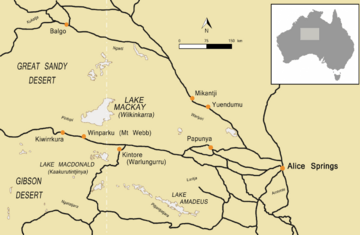Pintupi facts for kids

The Pintupi are an Aboriginal group from the Western Desert in Australia. Their traditional home is a very remote area west of Lake MacDonald and Lake Mackay in Western Australia. Because their land was so isolated, the Pintupi were among the last Aboriginal people to live their traditional way of life.
In the middle of the 20th century, many Pintupi people were forced to leave their homeland. This happened because of missile testing being done at Woomera. They were moved to settlements east and west of their country. These places included Papunya, Balgo, Haasts Bluff, and even Hermannsburg. This meant they were spread out into different communities. Sadly, within a few years, hundreds of Pintupi died from new diseases and infections. Others found it hard to deal with conflict, as they had lived in small groups for most of their lives.
During the 1960s, the Australian government had policies that aimed to make Aboriginal people live like Europeans. These policies had a big impact on many Pintupi. As part of this, hundreds of Pintupi children were taken from their parents and placed in missions or foster care. This sad period is now known as the Stolen Generation.
Starting in the 1970s, many Pintupi people in Papunya strongly wanted to return to their traditional lands. They moved back west in 1981 and set up Kintore (which they call Waḻungurru). Even further west, Kiwirrkurra was founded in 1983, close to Lake Mackay.
Pintupi Skin Names
The Pintupi people have a special system called "skin names." These names help define how people are related to each other. They also help decide who can marry whom. There are eight different skin groups. Boys and men have names that start with "Tj," like Tjapaltjarri. Girls and women have names that start with "N," like Napaltjarri. These names are not like European surnames. They are important for understanding family connections and traditions.
Related Information

